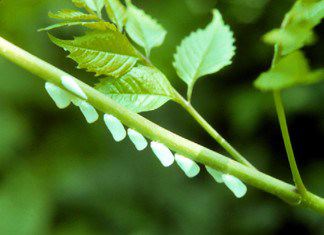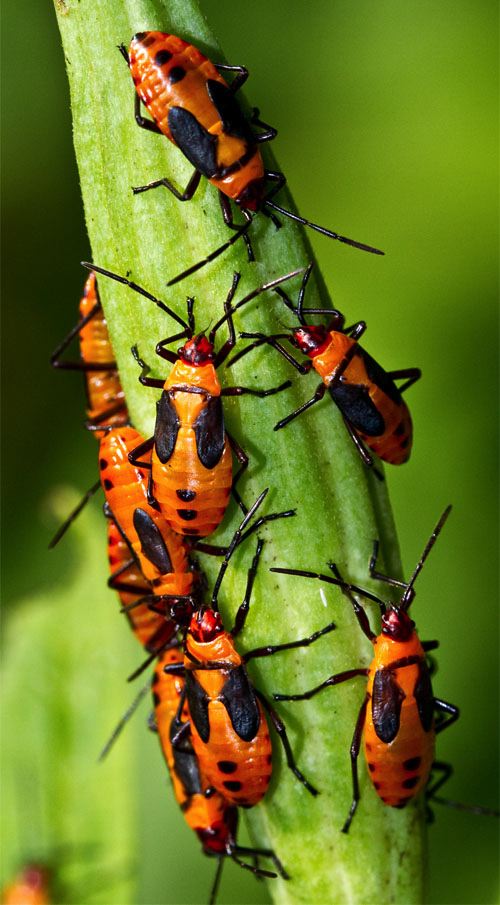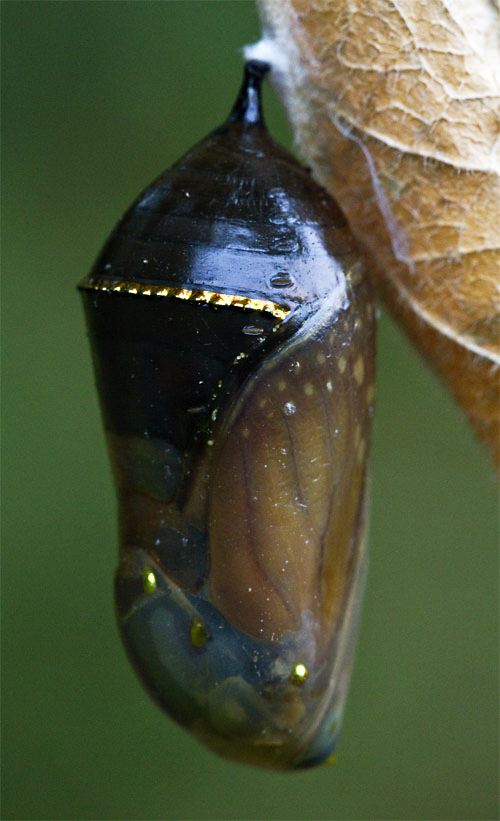|
|
|||
|
(Back to Preceding Week; on to Next Week) |
|
SWAMP MILKWEED REPRISE A couple of installments back we wrote about our admiration for a colony of Swamp Milkweed, Asclepias incarnata, that--through no fault of our own--had become established and was thriving at Hilton Pond Center. It's not often we re-visit a topic so quickly--if you count our Swamp Milkweed Leaf Beetle essay in June we've already written twice this summer about milkweeds--but this week so much was happening around the milkweed patch we couldn't ignore the opportunity to share our observations once again. It's amazing how much about the milkweed itself changed in just a fortnight, and that there's a whole new assortment of arthropod visitors to talk about in this week's "Swamp Milkweed Reprise."
All text & photos © Hilton Pond Center Two weeks ago Swamp Milkweed plants that had flowered 'way back in midsummer were firming up their seed pods--most of them bright green and pointing straight skyward. This week the pods were still erect but turning brown and, in a few cases, beginning to burst. One pod (above) had partially popped its seams to reveal a highly symmetrical complement of seeds laid down in overlapping layers. Attached to the upper end of each seed were fine silken threads, lined up parallel and waiting for the pod to open further.
All text & photos © Hilton Pond Center One neighboring milkweed plant, even further along, was already releasing its payload (above), with flattened brown seeds about to make their way toward freedom. As the pod dried and opened, each seed's straight silken threads curled down, forming a featherlight umbrella nicely adapted for hitching a ride on the next strong breeze--an effortless means of seed dispersal.
All text & photos © Hilton Pond Center As we photographed those soon-to-be-liberated milkweed seeds, we noticed a rather large insect (above) making its way up the stalk of another milkweed plant. At first glance its very long hind legs made us think it was a grasshopper, but when we saw its antennae were nearly twice the length of its 2.5-inch body we knew it was actually in the Katydid Family, the Tettigoniidae. Although such insects with elongated antennae are often called "long-horned grasshoppers," they're more closely related to crickets; their suborder, Ensifera, means "sword bearer" after the female's large blade-like ovipositor that shows in the photo above. True grasshoppers--sometimes referred to as "short-horned grasshoppers"--are taxonomically diverse and have short, stout antennae. Their large suborder, Caelifera, includes what folks commonly call "locusts."
All text & photos © Hilton Pond Center It only took several seconds for this Handsome Meadow Katydid, Orchelimum pulchellum--to crawl to the top of the milkweed stalk--and reveal her intentions. With strong, chewing mouthparts, the blue-eyed insect tore into a partly open milkweed pod (above) and started munching one at a time on ripened brown milkweed seeds. After eating her fill, the katydid crawled back down the stem and disappeared into surrounding vegetation, perhaps looking for an appropriate place on the ground to insert her ovipositor and lay her eggs.
All text & photos © Hilton Pond Center There was one other "hopper" on the milkweed, but it was far smaller and certainly couldn't be confused with either a "long-horned" or a "short-horned" grasshopper. It was a Northern Flatid Planthopper, Anormenis chloris (above), a ghostly greenish-white critter less than half an inch long. "Hopper" is a common epithet applied to diverse insects; there are the grasshoppers already mentioned, plus Treehoppers, Leafhoppers, and our Planthopper above.
All text & photos © Hilton Pond Center One find on the Swamp Milkweed this week was quite exciting for us because it was something we'd never actually seen before. When we examined a milkweed pod infested with tiny orange Oleander Aphids, Aphis nerii, one-sixteenth of an inch long, we noticed a long, slender brown creature sharing the space. Through our macro lens we could see it was some sort of immature insect--the six legs were a giveaway--that it had rather large and ominous-looking mouthparts, and that it bore two odd-looking bumps halfway down each side of its body. We figured the bumps were a clue to the insect's identity, that they were the buds of undeveloped wings, and that the way they were placed--relatively far apart--ruled out lots of insect groups. For a second we thought dragonfly or damselfly, but remembered their nymphs are aquatic and don't resemble the specimen at hand. That led us to think "lacewing" and since we knew lacewing larvae were predators on aphids it seemed like a logical answer. Sure enough, after we finished taking our photos and returned to the library at Hilton Pond Center, a search of insect references told us we had found the larval stage of a member of the Brown Lacewing Family (Hemerobiidae).
All text & photos © Hilton Pond Center Brown Lacewings are smaller than but similar in structure to Green Lacewings (Chrysopidae), even though their two families are not as closely related as once thought. Larvae and adults in both are deadly predators on aphids, scale insects, mites, mealybugs, whiteflies, and other small agricultural pests; as a result, lacewings are used as biological control agents that don't have the negative environmental impact of chemical pesticides. Adult Brown Lacewings bear fuzzy wings with long veins; they prefer wooded areas and typically are more secretive than Green Lacewings. Like virtually all insects, lacewings have some sort of predator; birds eat them, and they seem to be a favorite food item for spiders. (Curiously, as many times as we've looked at our Swamp Milkweed plants around Hilton Pond, we've never spotted any spiders.)
All text & photos © Hilton Pond Center Two weeks ago several milkweed pods were hosting late instars of the Large Milkweed Bug, Oncopeltus fasciatus, so this week it wasn't surprising these nymphs (below left) had metamorphosed into adults. What IS intriguing was both stages of these brightly colored insects have been pretty much oblivious to our camera work.
All text & photos © Hilton Pond Center On various days during the summer we saw as many as a half dozen Monarch caterpillars chowing down on leaves of our Swamp Milkweed plants, but this week we could find only one (above)--a fully grown final stage larva (fifth instar) about 2" long. Every since our Swamp milkweed colony established itself about a decade ago, we have kept close eye on these caterpillars that first showed up in 2005. After all, one reason to have milkweeds is because they're the primary host plant for Monarch butterflies, Denaus plexippus, and their young, but we'd never known whether the "cats" survived to adulthood. Despite their bitter, toxic taste Monarch caterpillars do get taken by wasps and other predators, and some larvae undoubtedly are eaten by unwary birds that never repeat the mistake. For ten years we have looked locally for a Monarch chrysalis, examining not only the milkweed colony but also neighboring vegetation where the caterpillars might have gone to pupate. Alas, we've never had any success--until, finally . . .
All text & photos © Hilton Pond Center . . . on the morning of 26 September we spied Hilton Pond Center's first known Monarch chrysalis (above), dangling from a dying yellow milkweed leaf. This was cause for much jubilation that only fellow naturalists and butterfly enthusiasts will understand. How satisfying it was to find this eye-pleasing gem, decorated with a row of golden dots and housing what soon will be a free-flying Monarch butterfly. When a Monarch caterpillar reaches optimal size and has fattened up sufficiently on its milkweed leaf diet, it becomes a pupa--the third stage of complete metamorphosis. Unlike moth caterpillars that spin their own sheltering cocoons, the pupal stage of a Monarch caterpillar is the result of a larval molt, i.e., what lies beneath the skin of the caterpillar during its final molt is the chrysalis.
All text & photos © Hilton Pond Center Despite the week's flurry of activity around our milkweeds, we know with the arrival of autumn such action soon will cease. Within a few more weeks every milkweed pod will have dried out and released its seeds,
All text & photos © Hilton Pond Center
|







 The latter three--with stylus-like sucking mouthparts--are in the True Bug Order (Hemiptera), albeit in different families, and all are capable of exploding away from a perch, hence the name "hopper." The Northern Flatid Planthopper occurs across the eastern U.S., sucking juices from as many as 40 species of plants but laying eggs primarily in twigs of Black Walnut and Pawpaw--both of which occur at Hilton Pond Center. We don't know whether the species actually makes use of Swamp Milkweed or just happened to be there; we suspect serendipity because only one individual was present and--as in the line-up above right on a Trumpet Creeper vine--when they're on host plants we usually observe several hoppers together.
The latter three--with stylus-like sucking mouthparts--are in the True Bug Order (Hemiptera), albeit in different families, and all are capable of exploding away from a perch, hence the name "hopper." The Northern Flatid Planthopper occurs across the eastern U.S., sucking juices from as many as 40 species of plants but laying eggs primarily in twigs of Black Walnut and Pawpaw--both of which occur at Hilton Pond Center. We don't know whether the species actually makes use of Swamp Milkweed or just happened to be there; we suspect serendipity because only one individual was present and--as in the line-up above right on a Trumpet Creeper vine--when they're on host plants we usually observe several hoppers together.


 Sometimes one or two moved to the far side of a milkweed pod as we tried to get in close, but most--like the adult above--simply stayed put as we fired off multiple exposures and, as with all photos in this week's installment, our built-in electronic flash. (It's worth noting both adult and immature bugs are laden with toxic glycosides from their milkweed diet; perhaps this makes them so unpalatable they need not waste energy escaping predators.) Even though we didn't see any bugs mating, undoubtedly it will occur soon; the female bug mates 5-12 days after molting into her adult stage, compared to 2-3 days for males. Female Large Milkweed Bugs are amazingly fecund, laying 30 eggs per day for up to two months! Each egg is laid in a tight crevice on the milkweed plant, a safe place where it will overwinter and hatch next year unless discovered by a hungry chickadee or some other "eggivore."
Sometimes one or two moved to the far side of a milkweed pod as we tried to get in close, but most--like the adult above--simply stayed put as we fired off multiple exposures and, as with all photos in this week's installment, our built-in electronic flash. (It's worth noting both adult and immature bugs are laden with toxic glycosides from their milkweed diet; perhaps this makes them so unpalatable they need not waste energy escaping predators.) Even though we didn't see any bugs mating, undoubtedly it will occur soon; the female bug mates 5-12 days after molting into her adult stage, compared to 2-3 days for males. Female Large Milkweed Bugs are amazingly fecund, laying 30 eggs per day for up to two months! Each egg is laid in a tight crevice on the milkweed plant, a safe place where it will overwinter and hatch next year unless discovered by a hungry chickadee or some other "eggivore."

 When first formed the chrysalis is a delicate pale jade green (right), but as the insect inside becomes more mature the structure darkens. Through the transparent wall of the chrysalis (above), one can even see the butterfly's orange wings with black veins and white spots, an indication the occupant is nearly ready to expupate. This final event occurs when the butterfly takes air in through its thoracic spiracles, expands its body, and splits the cuticle of the chrysalis. Such metamorphosis magic must have been going on somewhere with regularity in recent days, for when we scanned the skies above Hilton Pond this week looking for migrant raptors, we saw dozens of migrating Monarch butterflies instead. We suspect the adult developing inside our our recently discovered Monarch chrysalis will be joining this southbound "butterflock" in just a few days.
When first formed the chrysalis is a delicate pale jade green (right), but as the insect inside becomes more mature the structure darkens. Through the transparent wall of the chrysalis (above), one can even see the butterfly's orange wings with black veins and white spots, an indication the occupant is nearly ready to expupate. This final event occurs when the butterfly takes air in through its thoracic spiracles, expands its body, and splits the cuticle of the chrysalis. Such metamorphosis magic must have been going on somewhere with regularity in recent days, for when we scanned the skies above Hilton Pond this week looking for migrant raptors, we saw dozens of migrating Monarch butterflies instead. We suspect the adult developing inside our our recently discovered Monarch chrysalis will be joining this southbound "butterflock" in just a few days.
 and withering milkweed stems and leaves will be producing insufficient milky sap (right) to nourish hungry bugs or aphids. Even now, whatever foliage hasn't been devoured by Monarch caterpillars is being attacked by what appears to be powdery mildew (above). Eventually, every tall milkweed stem along the banks of Hilton Pond will die back to ground level, with roots remaining viable in this perennial native plant. Death matters not, however, now that our milkweed colony and all the critters it supports have arranged to pass their genes to a new generation--a generation that next year may give us reason to write yet another "Swamp Milkweed Reprise."
and withering milkweed stems and leaves will be producing insufficient milky sap (right) to nourish hungry bugs or aphids. Even now, whatever foliage hasn't been devoured by Monarch caterpillars is being attacked by what appears to be powdery mildew (above). Eventually, every tall milkweed stem along the banks of Hilton Pond will die back to ground level, with roots remaining viable in this perennial native plant. Death matters not, however, now that our milkweed colony and all the critters it supports have arranged to pass their genes to a new generation--a generation that next year may give us reason to write yet another "Swamp Milkweed Reprise."